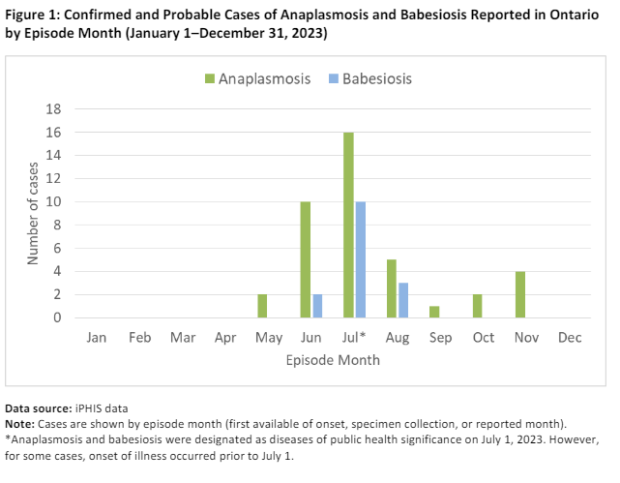Ontarians heading outdoors this summer are likely well-versed on the potential risk of Lyme disease that comes with a tick bite.
But there are three other pathogens that can be transmitted by blacklegged ticks that public health officials want you to know about – and confirmed cases have already been reported in Ontario.
Last month, Public Health Ontario (PHO) released an enhanced epidemiological summary on anaplasmosis, babesiosis and Powassan virus, all three of which were designated as “diseases of public health significance” by the Ministry of Health on July 1 of 2023.
According to the report, last year there were 40 cases of anaplasmosis in Ontario (17 confirmed and 23 probable) and 15 cases of babesiosis (eight confirmed and seven probable). There were no reported cases of Powassan virus.
Most of the cases were reported in the summer months, with 16 cases of anaplasmosis and 10 cases of babesiosis logged in July.
PHO data shows that the majority of the anaplasmosis infections were reported by public health units in eastern Ontario, including Kingston-Frontenac and Lennox and Lexington (KFL&A Public Health), where between 13 and 15 cases were reported.
The babesiosis cases were more widespread, with at least two infections reported in Toronto.
But what are these diseases and how do they differ from Lyme disease?
CTV News Toronto spoke with Dr. Richard Mather, PHO’s public health physician lead for vector-borne diseases, to learn more about the pathogens creeping up in Ontario and how people can protect themselves.
What are the symptoms of anaplasmosis? Babesiosis?
Mather explained that during early infection, it’s hard to distinguish between anaplasmosis, babesiosis and Lyme disease, because all three can cause flu-like symptoms, including fevers, chills, muscle aches and a headache.
However, Mather said one “big difference” is that the characteristic bullseye-like rash that appears in 70 to 80 per cent of people infected with Lyme disease does not appear in individuals infected with anaplasmosis or babesiosis.
“Most people will have a mild illness, [which is] self limiting, so it will get better on its own without treatment, which is often within 30 days,” he said. “But for some people, they can have severe disease. Severe symptoms could include things including respiratory problems, bleeding problems, organ failure, or death.”
Groups that are at risk of severe outcomes following an anaplasmosis or babesiosis infection include older adults, immunocompromised individuals and those with a delayed diagnosis.

“Severe disease isn’t that common. Some estimates by the Public Health Agency of Canada say that five to seven per cent of [anaplasmosis] patients would require intensive care and the case fatality rate is estimated at 0.6 per cent.”
Due to the “overlapping symptoms,” Mather said the only way to determine which disease you may be infected with is through bloodwork at a medical facility.
What do I do if I get bitten?
If you do find a tick on you, you should remove it as soon as possible and make sure not to crush or damage it in the process.
“You want to grasp it with tweezers as close to the skin as possible, so you’re taking the whole tick off and not leaving part of it on your body. Wash the area with soap and water and monitor yourself for the signs and symptoms of these tick-borne diseases,” Mather said.
If you suspect a tick has been attached to your body for more than 24 hours, the minimum amount of time required for the transmission of Lyme disease, or you’re developing symptoms, Mather suggests contacting your local health-care to discuss potential for medication to prevent Lyme disease.
“Post-exposure prophylaxis (PEP) is available to prevent Lyme disease, but not currently recommended as a preventative medicine for those other diseases.”
If you suspect the tick has been attached for less than 24 hours, and you don’t have any symptoms, you don’t necessarily need to see a doctor, Mather said, but you should remove the tick right away and self-monitor.
[embedded content]
Lyme disease has been a publicly-reported disease in Ontario since 1988. Why are these diseases only being reported now?
While Mather said he couldn’t speak to the specific reasons why anaplasmosis, babesiosis and Powasson virus were listed as diseases of public health significance by the Ontario’s health ministry last July, he said there has been an increase in the number of cases in areas surrounding Ontario.
“So because we know we have the ticks that can transmit these diseases in Ontario, and we are seeing increasing number of the diseases in the States or provinces around Ontario, we can anticipate there’ll be an increased number of cases of these diseases in future years,” he said.
Mather said PHO is expecting the areas in which blacklegged are found in Ontario to increase in the future, due to a number of factors, including climate change, the migration of animal host species as well as land use pattern changes, which will bring more people into contact with the arachnids.
Mather anticipates that the number of anaplasmosis and babesiosis cases reported at the end of this year will be higher than 2023, largely because there will be a full 12 months of data to pull from and more awareness about the pathogens.
So far, in 2024, Ontario has seen one case of babesiosis and no cases of anaplasmosis or Powassan virus. Meanwhile, 102 cases of Lyme disease have been confirmed. In 2023, there were 1,795 confirmed or probable cases of Lyme disease.
How can I protect myself?
Officials say protecting yourself against anaplasmosis, babesiosis and Powassan virus comes down to prevention.
“Similar to Lyme disease, there’s no vaccine for these diseases. So the best way to avoid infection is to prevent a tick bite,” Mather said.
Ontarians are encouraged to wear light-coloured clothing, so it’s easier to see ticks, closed-toed shoes, long-sleeved shirts and long pants tucked into socks when entering a wooded area or an area with tall grass or bushes.
Using insect repellant is also recommended, but make sure it contains DEET or icaridin, and spray it on your clothes and exposed skin.
Once you get back indoors, check yourself and your children for ticks.
If you spot a tick on your clothing, throw those items in the dryer on high heat for at least 10 minutes before washing.

Source link
Related

























Comments